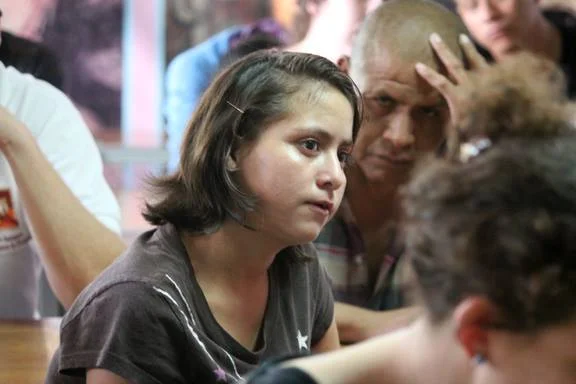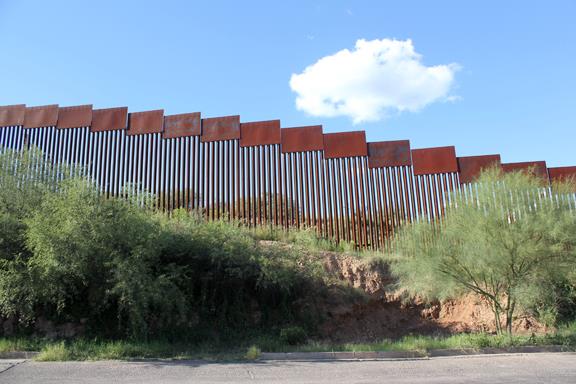Let us forge a state of union
A place where every child is
A child
Where you see me and I see you
I mean really see each other as extensions
one of one another
From People’s State of the Union commentary by
Makani Themba, Minister of Revolutionary Imagination,
U.S. Department of Arts and Culture National Cabinet.
I haven’t the faintest idea how to sum up the more than 500 stories uploaded to the People’s State of the Union website since late January. They came from story circles—a hundred people in a church basement or a handful in someone’s kitchen—organized in more than 150 places around the U.S. They came because people resonated with the USDAC’s assertion that “democracy is a conversation, not a monologue.” Because they know the stories that reveal the state of our union. Because—despite falling through the many rips in our social fabric—they believe in democracy and they want a say in how it unfolds.
I could say that a huge chunk of stories are about yearning for our stated ideals to be true, true enough to live into all day, every day. I could say that another huge chunk is about standing together despite the many discouragements unchecked power and privilege have put in our path. I could say that they speak of hearts broken by disappointment, and hearts remade by beauty and the hope of resilience. I could say that they demonstrate a powerful desire to share truth, risking vulnerability to find common ground.
I could say that the stories taken together prove that the quintessential act of art—turning one’s experience into something shapely that can be shared—is also the quintessential act of healing, the medicine we need. But I think I’ll let Luis J. Rodriguez say it with a few lines from the sonnet he wrote for another part of the People’s State of the Union, the Poetic Address to the Nation:
Give me Crooklyn, cowboys, cool jazz, cholos.
Give me libraries, gardens of the muse.
Give me songs over sidewalks, mad solos.
Big America improperly sized.
Give me your true value, realized.
I could say all of these things and they would be only part of the truth revealed by the People’s State of the Union, the USDAC’s first new civic ritual. See for yourself.
Many stories are rich in incident and detail, with characters and plots. A sizeable number comprise just a few sentences, like these by an 11 year-old Bronx resident named Jade:
In school they have special ed in every grade. A lot of people make fun of the special ed kids. I said, what’s wrong with them? They just have some problems, but they are no different. I got bullied too, but I stand up for them. There should be no difference.
These are the things that give me hope for the human race: that we open our hearts in compassion for others even when we don’t face the obstacles and injuries that dog them. That we refuse to cede room in our minds to the voices that tell us we are less than, as a young woman in Chicago wrote in describing a welcome epiphany:
As a mixed race person, you always feel stuck in between two worlds—I never feel Black enough, I never feel Hispanic enough, and then I never feel queer enough. But it was this one moment where I was like, “I am enough for that.” And I am enough of each of these things. That made me feel like a weight off my shoulders. I’ll be 27 next month, and after 26 years, I finally feel like I’m enough.
That we persist in reaching across the evident differences that can be barriers to find places of heart-opening connection, as a man in Brooklyn wrote of a mid-December taxi ride:
I got in a taxi to go from Manhattan to Brooklyn on a rainy winter’s night.
After requesting my destination, the cabbie said, “I’m sorry but we can’t take the Brooklyn Bridge. It’s been shut down for the past three hours.”
I smiled and said, “I’m so glad we can’t take the Brooklyn Bridge.”
“Me too,” he smiled back.
We looked at each other and silently understood.
The bridge was closed from tens of thousands protesting the Staten Island grand jury’s decision NOT to indict NYPD Officer Daniel Pantaleo for the death of Eric Garner.
That despite the repetition of racism, the hammering injury of constant vilification, we persist in standing for justice, as a community arts student from Baltimore wrote:
I was saying, you know, there’s a lot of art being made, Selma and other art circulating in pop culture. I was saying that civil rights happened, but we still don’t have the right to be angry. If we’re angry, then we’re angry black men and women. We’re human. We have every emotion that everyone else has. But when we express emotions that everyone else has, we’re labeled, we’re crazy. We can be demonized.
That we have such a powerful drive to bring awareness to our lives despite many temptations to curtail self-questioning, as a man in San Francisco shared in this account of examining his own feelings:
I think I am still trying to make peace with my belief that race does not have to be the dominant way I experience this country. In a country dominated by a white culture, with a few token exceptions, there are no English Americans or Scandinavian Americans; so does there have to be Asian Americans and African Americans? Aside from the fact that this completely ignores what history has to say about it (race has always been important), I sometimes wonder if my conviction is in natural opposition to race pride and diversity. I’m not advocating for homogeny, but I wonder if I naturally incline towards dreaming an idealized world that may just never exist—because the reason why race pride needs to exist is because hate words and hate crimes and police brutality and institutionalized racism exist.
That we have the capacity to awaken from the trance of not-seeing, as a woman from Austin described in a moment that obliterated her sense of belonging:
I was raised Jewish in the Bible belt suburbs of Atlanta, Georgia. One Monday during lunch my three best friends sat down at the cafeteria table with me and said, “We learned in Church yesterday that you’re going to hell.” They looked at me, questioning. I said, “Well, Jews believe anyone who is good can go to whatever they believe is Heaven.” After some silence, one said, “I like that better” and the conversation changed. The others never commented. I had taken for granted that I belonged, and in an instant that was shattered. When I was an adult I spent years traveling and living overseas. 26 years later I am only just starting to find feelings of belonging in the U.S. again.
My heart is full.
If you haven’t already, please sign up to receive USDAC updates, including our next national action, and take part in our work.
Stevie Wonder has been touring with a live version of his classic, epic album, Songs in the Key of Life. This one has got to be the People’s State of the Union’s anthem, the trilingual (Zulu/Spanish/English) “Ngiculela – Es Una Historia – I am Singing.”
Es una historia de manana/It is a story of tomorrow
Es una historia de amor/It’s a love story
es una historia en la que el amor reinará/It’s a story in which love will reign
Por nuestro mundo/For our world
Es una historia de mi corazon/It is a story of my heart




























